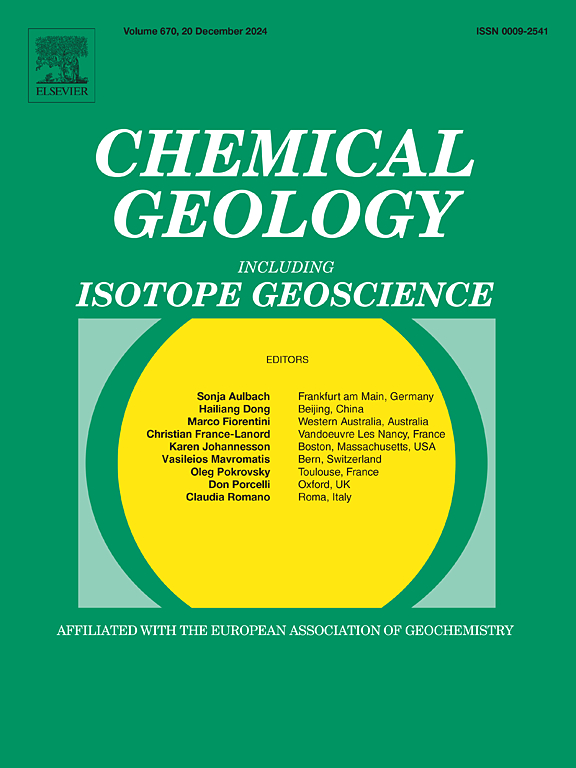紫阳—朱溪碱性岩中磷灰石的结构和化学变化:岩浆和热液过程中稀土元素迁移的意义
IF 3.6
2区 地球科学
Q1 GEOCHEMISTRY & GEOPHYSICS
引用次数: 0
摘要
磷灰石是一种普遍存在的富含稀土元素的副矿物,对揭示碱性岩石中稀土元素的行为具有重要意义。本文研究了南秦岭紫阳—竹溪地区一系列碱性火山—侵入岩中磷灰石的结构、元素和RbSr同位素组成,包括辉长岩(辉长岩、玄武岩、辉长岩和辉绿岩)、闪长岩(辉长闪长岩和角闪长二长岩)和正长岩(黑云母正长岩和粗面岩)。在所研究的岩石中,发现了两种主要类型的磷灰石,岩浆和交代磷灰石。岩浆磷灰石(Ap-1)以自面体六方晶体为代表,通常以包裹体形式存在于辉石、角闪洞和长石中。交代磷灰石(Ap-2)一般产于正长岩中,具有明显的交代结构,常与次生独居石伴生。在Ap-1中,LILE (Sr、Ba等)和相容元素(V、Sc等)由碱性基性岩向长英质岩递减,表明长石和辉石、角闪孔等基性矿物的分选作用主导了岩浆演化过程。稀土元素含量(ΣREE从4060 ~ 37100 ppm)相应增加,表明岩浆演化促进了残余熔体中稀土元素的富集。另一方面,交代磷灰石(Ap-2)的ΣREE含量(平均值为10480 ppm)明显低于岩浆磷灰石(Ap-1)(平均值为30890 ppm),表明原生磷灰石在热液交代过程中有稀土的浸出过程。从磷灰石中浸出的稀土元素(~ 30%)要么沉淀到独居石中作为原位替代品,要么被重新激活并在当地迁移。Ap-2的Sr含量和87Sr/86Sr比值(0.7090 ~ 0.7107 vs 0.7033 ~ 0.7046)高于Ap-1,表明Sr来自晚期热液的外部贡献。因此,我们认为研究的碱性岩的稀土富集机制可归结为岩浆分馏结晶-热液交代两大过程。本文章由计算机程序翻译,如有差异,请以英文原文为准。
Textural and chemical variation of apatite from Ziyang-Zhuxi alkaline rocks (Central China): Implications for REE migration during magmatic and hydrothermal processes
Apatite is a ubiquitous rare earth elements (REE)-rich accessory mineral of great significance in revealing the behavior of REE in alkaline rocks. This study investigates the textural, elemental, and Rb![]() Sr isotopic compositions of apatite from a series of alkaline volcanic-intrusive rocks in the Ziyang-Zhuxi region of the South Qinling Belt (China), including gabbroic rocks (pyroxenite, basalt, gabbro, and diabase), dioritic rocks (pyroxene diorite and amphibole monzonite), and syenitic rocks (biotite syenite and trachyte). Two main types of apatite, magmatic and metasomatic, have been identified in the studied rocks. The magmatic apatite (Ap-1) is represented by euhedral hexagonal crystals and commonly occurs as inclusions in pyroxene, amphibole and feldspar. The metasomatic apatite (Ap-2) generally occurs in syenitic rocks, exhibiting obvious metasomatic textures and is commonly associated with secondary monazite. In Ap-1, the LILE (e.g., Sr, Ba) and compatible elements (e.g., V, Sc) decrease from alkaline mafic rocks to felsic rocks, indicating that fractionation of feldspars and mafic minerals such as pyroxene and amphibole dominated the magma evolution process. The REE contents (ΣREE from 4060 to 37,100 ppm), however, increase accordingly, suggesting that magma evolution promotes REE enrichment in the residual melt. On the other hand, the metasomatic apatite (Ap-2) displays obvious lower ΣREE contents (mean of 10,480 ppm) than their magmatic apatite (Ap-1) counterparts (mean of 30,890 ppm), indicating a leaching process of REE from primary apatite during hydrothermal fluid metasomatism. The leached REE from apatite (∼30 %) either precipitated into monazite as an in-situ replacement or were remobilized and migrated locally. The higher Sr contents and 87Sr/86Sr ratios of Ap-2 than those of Ap-1 (0.7090–0.7107 vs 0.7033–0.7046) indicate an external contribution of Sr from the late hydrothermal fluids. Therefore, we propose that the REE enrichment mechanism of the studied alkaline rocks can be attributed to two major processes: magma fractional crystallization followed by hydrothermal metasomatism.
Sr isotopic compositions of apatite from a series of alkaline volcanic-intrusive rocks in the Ziyang-Zhuxi region of the South Qinling Belt (China), including gabbroic rocks (pyroxenite, basalt, gabbro, and diabase), dioritic rocks (pyroxene diorite and amphibole monzonite), and syenitic rocks (biotite syenite and trachyte). Two main types of apatite, magmatic and metasomatic, have been identified in the studied rocks. The magmatic apatite (Ap-1) is represented by euhedral hexagonal crystals and commonly occurs as inclusions in pyroxene, amphibole and feldspar. The metasomatic apatite (Ap-2) generally occurs in syenitic rocks, exhibiting obvious metasomatic textures and is commonly associated with secondary monazite. In Ap-1, the LILE (e.g., Sr, Ba) and compatible elements (e.g., V, Sc) decrease from alkaline mafic rocks to felsic rocks, indicating that fractionation of feldspars and mafic minerals such as pyroxene and amphibole dominated the magma evolution process. The REE contents (ΣREE from 4060 to 37,100 ppm), however, increase accordingly, suggesting that magma evolution promotes REE enrichment in the residual melt. On the other hand, the metasomatic apatite (Ap-2) displays obvious lower ΣREE contents (mean of 10,480 ppm) than their magmatic apatite (Ap-1) counterparts (mean of 30,890 ppm), indicating a leaching process of REE from primary apatite during hydrothermal fluid metasomatism. The leached REE from apatite (∼30 %) either precipitated into monazite as an in-situ replacement or were remobilized and migrated locally. The higher Sr contents and 87Sr/86Sr ratios of Ap-2 than those of Ap-1 (0.7090–0.7107 vs 0.7033–0.7046) indicate an external contribution of Sr from the late hydrothermal fluids. Therefore, we propose that the REE enrichment mechanism of the studied alkaline rocks can be attributed to two major processes: magma fractional crystallization followed by hydrothermal metasomatism.
求助全文
通过发布文献求助,成功后即可免费获取论文全文。
去求助
来源期刊

Chemical Geology
地学-地球化学与地球物理
CiteScore
7.20
自引率
10.30%
发文量
374
审稿时长
3.6 months
期刊介绍:
Chemical Geology is an international journal that publishes original research papers on isotopic and elemental geochemistry, geochronology and cosmochemistry.
The Journal focuses on chemical processes in igneous, metamorphic, and sedimentary petrology, low- and high-temperature aqueous solutions, biogeochemistry, the environment and cosmochemistry.
Papers that are field, experimentally, or computationally based are appropriate if they are of broad international interest. The Journal generally does not publish papers that are primarily of regional or local interest, or which are primarily focused on remediation and applied geochemistry.
The Journal also welcomes innovative papers dealing with significant analytical advances that are of wide interest in the community and extend significantly beyond the scope of what would be included in the methods section of a standard research paper.
 求助内容:
求助内容: 应助结果提醒方式:
应助结果提醒方式:


